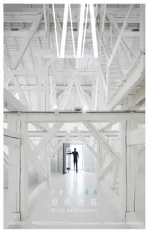立陶宛居住建筑
2018-06-19马塔斯苏普辛斯卡斯Matasiupinskas
马塔斯·苏普辛斯卡斯/Matas Šiupšinskas
陈茜 译/Translated by CHEN Xi
“居住”与家庭生活是建筑学科的基本概念之一。建筑师要面对由处理私人空间所带来的额外限制,并与居住空间的未来使用者建立密切的关系。这并非轻而易举的事,更何况还需在空间的表现力与便利性之间寻求适度的平衡。居住空间首先作为某人的家而存在,也是其被视为建筑作品而赋予表现力的先决目标。但家庭空间又恰恰呈示了丰富地区性的建筑类型——人的生活习惯、价值观、居住传统。简而言之,与相对宏大的公共建筑相比,居住建筑能够更加显著地反映出文化传统、社会关系及当地经济状况。
近年来,住宅设计思想广泛的跨国传播令家庭空间愈加全球化。各类建筑出版物令不同区域的住宅类型得以传播共享,也令建筑师比以往更易了解多样的住宅设计项目。同时,常规客户的意愿不再仅受制于其个人经验,还受到无数网络图像信息流的冲击(如Pinterest, Instagram等)。对地产开发商来讲亦是如此,其他城市甚至国外的成功案例成为其着力尝试的全新发展计划。尽管对家庭空间的审美差异正日渐消解,固有的日常生活习惯也在缓慢改变,气候条件作为阻止同一性在全球蔓延的仅存因素之效力也有所折扣。尽管如此,它仍然是保持本土建筑特殊性的一种值得玩味的方式。那么,我们应当如何描述立陶宛日常建筑的特殊性呢?又是哪些作用力塑造了其特殊性?
首先,立陶宛建筑的灵感始终受到乡村传统的影响。这一影响孕育自两次世界大战期间(1918-1939),直到苏维埃时代仍保持主导地位。彼时,寻求建筑中的民族特色是流行且被广泛接纳的做法。乡村出身者占据了知识分子的可观比例,他们从乡村来到城市接受教育。早期现代主义正值繁荣的年代中,乡村文化成为本土建筑师常见的灵感来源。这种灵感源头刚好可以解释木材的使用在立陶宛建筑中的流行,以及现代设计中某些细部与图案的使用。居住单元的类型和空间组织有时也受到乡村建筑范例的影响,但踪迹远不如风格影响的证据来得明显。
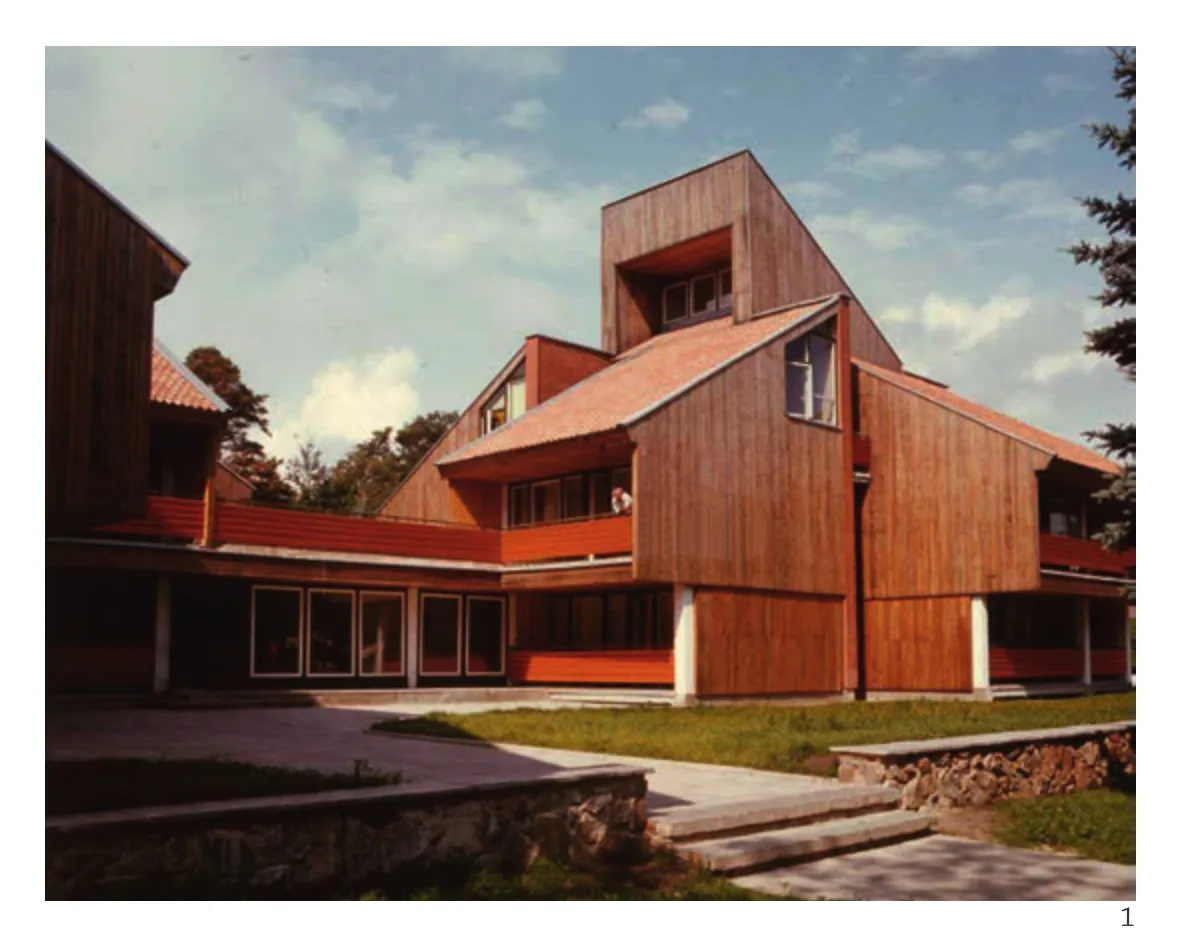
1维陶塔斯·迪丘斯和列奥尼达斯·兹博卡斯设计的立陶宛科学院休闲中心(1982)诠释了对木材的广泛使用及与大自然的关系/Lithuanian Academy of Sciences Recreational Complex (1982), designed by Vytautas Dičius and Leonidas Ziberkas shows subtitle relation with nature and extensive use of wood.
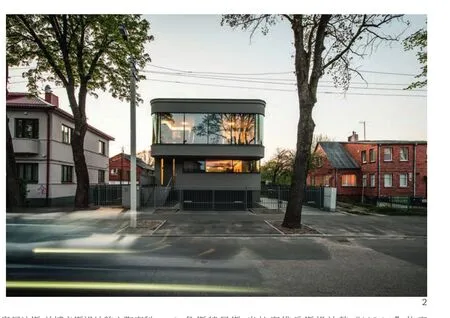
2鲁斯特尼斯·米拉赛维丘斯设计的“MR21”住宅(2016),展现了战间的显著影响,并呈现了历史住宅区对选址的考量——赞利亚卡涅斯/House "MR21" (2016)designed by architect Rūstenis Milaševičius. It shows the clear influence of Interwar period and also respects towards genius loci of the historic residential area – Žaliakalnis.
第二重影响则来自于国外的职业建筑方法。两次世界大战期间,大多数本土建筑师都在诸如巴黎、苏黎世、布鲁塞尔、柏林、圣彼得堡之类的城市接受教育。与此同时,外国建筑师已经开始在立陶宛展开项目。花园城市运动的影响便可见于维尔纽斯、考纳斯等城市的住区规划方案中。而后在苏联时期,斯堪的纳维亚国家的设计思想强烈影响了立陶宛本土建筑师。举例来说,芬兰旅行的所见深远影响了材料与细部的表达方式。干净而简洁的建筑语言、本土材料的使用以及对自然之美的聚焦成为了主导(图 1)。
尽管北欧建筑的影响显著,乡村建筑的启示仍旧存在——两者相互融合且并存至今。即使在立陶宛重获独立后、建筑界历经重大机构变动的时期,新材料、实验派、后现代主义种种思潮迭起,仍未能撼动这两种影响的生命力。由于建筑师职业依赖于密切合作的师徒关系,传递给下一代的经验中裹挟了明显的本土文化特质。比如,无论过去还是当下,两次世界大战间的现代主义总被时常提及成为当代建筑的一个重要灵感来源。或许由于这种代际传递与代际间的密切合作关系,对立陶宛建筑来说,这种价值观直至今日依然保持其重要性(图2)。
数年来,大型住宅街区一直是立陶宛住宅建筑的核心主导类型,在此类项目中本土建筑师尽可能克服严苛的规范限制并尽力革新标准化的苏联式设计。同时,在面对为艺术家、音乐家和社会名流而设计的住宅项目时,建筑师们得以有机会尝试更多。尽管这类项目稀少而特殊,却提供了设计技巧的发挥空间,并为住宅设计累积了经验。度假村也在同时期得到迅速发展,也为建筑师提供了向这类建筑汲取经验的机会。
立陶宛独立后,独栋住宅合法化迅速成为流行。年轻建筑师通过此类住宅项目获得了通过新想法与新材料来表达自我设计观念的极佳机会。1990年代初,后现代主义仍旧甚嚣尘上,对于自己的第一个居所,业主们又往往难以明确需求。试错过程中难以避免的早期极端设计逐渐被新生代建筑师与众不同且具有辨识度的住宅设计所取代。
转折不仅发生在建筑设计领域,更重要的是对生活方式的改变。从集体公寓和大型住宅街区向更加私有化、个人化的居住空间的转变十分剧烈——建筑师与业主都需要时间来调整以适应新的生活方式并发展出因应的贴切建筑语汇。住宅建筑一度曾失去其对环境的谦逊态度,但很快吸取了教训。无疑,对于自然和城市的语境关系之重要性又重回建筑师的视野当中,而独立建筑师们尽可以发挥其对建筑语境处理的创造性方法(图3-5)。
The concept of "living" and domesticity is one of the fundamental ones for architectural discipline. Also,an architect is much more limited when working with personal space and have to develop a very intimate relationship with the future user. Not everybody is capable to do that and also to find a proper balance between expression and convenience. First of all,residential space will be home for somebody and only after achieving this goal you can start thinking how expressive it could be as a piece of architecture.However, domestic architecture is the one that expresses locality very well – it shows habits and values that people have and tradition of habitation.To put it simply - residential architecture is capable to reflect the cultural traditions, social relationships and state of the local economy in a much more evident way than the grandiose public buildings.
During the recent decades, housing design ideas spread through countries and domestic architecture became more and more globalised. Architectural publications helped to share knowledge about housing typologies of different regions and architects are more informed about a variety of residential designs than ever before. At the same time wishes of the regular client are shaped not only by their personal experience but by a nameless flow of web images as well (Pinterest, Instagram etc.). Real estate developers are doing the same by trying new development schemes that proved to be working in other cities and countries. It seems that only the climate limits a uniformity around the world, but it is not completely true - even if the difference in aesthetics of domestic architecture are dissolving habits of everyday life are changing slowly and by this local architecture remains specific and interesting to learn about. So how can we describe what is specific to the Lithuanian architecture of everyday life? And what are the forces shaping it?
First of all, Lithuanian architecture was always inspired by rural tradition. This influence emerged during the interwar period (1918-1939) and remained dominant during the Soviet years as well. Searching for national identity in architecture was popular and acceptable at the time. A significant portion of the new intelligentsia was born in villages and came to cities to get an education. Early Modernism flourished at the time and local architects often used rural culture as a source of inspiration. Such inspiration could explain the popularity of wood in Lithuanian architecture,and also some of the details and patterns used in a modern design. Typology of residential units and spatial organisation sometimes were also influenced by the examples of rural architecture, but such traces are less evident then stylistic inspiration.
The second source of influence was professional architecture from abroad. During the interwar period,most of the local architects were educated in such cities as Paris, Zurich, Brussels, Berlin, Saint Petersburg and others. At the same time, foreign architects were already working in Lithuania. Urban plans of residential areas inspired by garden city movement appeared in Vilnius and Kaunas cities. Later – during the Soviet period Scandinavian countries became a strong influence for local architects. For example, trips to Finland made a great effect on how materials and detail were approached. Clean, laconic architectural language, local materials and a focus on the beauty of nature became dominant (Fig. 1).
Despite Scandinavian influence traces of rural inspiration were not forgotten – both of these aspects merged together and coexists till now. Even after Lithuania regained its independence and architectural field underwent major organisational changes these influences outlived influx of new materials, naïve experimentation, and echoes of Postmodernism. Since architect's profession is dependant on a close cooperation between the master and its apprentice – experience was transmitted to further generations together with a distinctive local cultural code. For example, Interwar Modernism was and still is often mentioned as a strong source of inspiration for contemporary architecture.Maybe because of such transfer and because of close cooperation between generations these values remained important in Lithuanian architecture to this day (Fig. 2).
For decades the most dominant typology of residential architecture in Lithuania was mass housing blocks. Local architects were trying to overcome strict regulation and update the standard Soviet designs as much as they could. At the same time, they had a possibility to experiment more when designing residential projects for artists, musicians or elite of the time. Even if this was a rare and specific case it allowed sustaining a certain level of skills and gain experience in residential design. At the same time resorts were developed heavily and there was a possibility to learn from holiday homes and sanatoriums as well.
After gaining independence, detached residential houses became legal and extremely popular typology.By designing such houses young architects had a great chance to express their aspirations by improvising with new ideas and materials. Postmodernism was still popular during the early 1990s and also clients were not sure about their real needs when building the first house. There were mistakes made during the process of trial and error, but excessive early designs slowly were outnumbered by the distinctive, but subtitle houses designed by the new generation of architects.
The turning point was happening not only in the architectural design but most importantly in a transformation of the way of life. The shift from communal apartments and mass housing blocks towards more personalised residential space was a drastic one – time was needed both for architects and for the clients to adjust to the new lifestyle and to develop the proper architectural vocabulary capable of dealing with such lifestyle. For a short period, residential architecture had lost its moderated approach towards the environment, but soon lesson was learned. Importance of contextual relation to nature and the city surely came back to the field even if individual architects had their personal creative approach how context should be treated (Fig. 3-5).
One of the architects that became well known for his expressive residential architecture is Gintautas Natkevičius. His studio was able to design very different houses in recent decades, but the main feature of these projects was an ambitious play between form, structure, and materials. His projects are usually provocative, often eye-catching, but Natkevičius is able to reach a dialogue between context and the newly built structure quite well.Family house in farmstead was built in 2010, it lays calmly on the field and next to the water. Playful observation room on top of a low, horizontal building strengthens the impression of the vast horizontal plot and gives a possibility to climb above the ground floor to see even further away. Family house in Utriai is quite opposite – it is expressively cantilevered and sticks out from the green landscape. It is an eye candy in a monotonous environment, more egoistic yet playful piece of architecture.
金陶塔斯·纳特科维丘斯是以具有表现力的住宅建筑而获得闻名的建筑师之一。他的工作室近年来完成了各异的住宅作品,但这些项目皆因对形式、结构和材料富有雄心的精妙操作而烙印上工作室的鲜明特色。尽管其作品往往具有强烈的煽动性和视觉吸引力, 纳特科维丘斯仍能在固有环境与新建结构间建立良好的对话关系。建于2010年的农场住宅静立于田野之中,水涧之滨,戏剧性的瞭望室被置于低矮的水平体量上方,强化了水平延展的广袤土地,同时提供了攀爬到地面之上而极目远眺的可能性。乌特里艾家庭住宅的处理却刚好相反——巨大而强烈的悬挑从绿色景观中伸展出来,使这座极度自我而戏剧化的建筑成为单调环境中的点睛之笔。
同样由纳特科维丘斯工作室设计的草莓街住宅则显得温润而内向,它的内部庭院对邻里隐藏起来,却对山谷和交汇的河流敞开视角。地块的复杂形状也成为了灵感的一部分——建筑师设想了一个几乎占据整个场地的形体。由锈钢板构成的立面融合进了纠缠不清的环境中,增加了街区层化的、未建成似的氛围基调。抛光的、开敞的内部立面围绕着带有花园的小庭院展开,这个空间虽作为建筑的中心元素,从视觉与构成的双重角度联系起了各个空间,却能够不断吸引观者的注意,不断带来惊喜(图6、7)。
阿克吐里建筑师工作室的作品中却呈现出截然不同的建筑操作方法。他们力图强调对自然与城市环境的清晰认知,以及对遗产、传统和自然材料的尊重。这个团队始终探索着如何以独有的建筑细部为简洁形式赋予有趣的叙事。以湖畔别墅为例,单色木条板包裹了住宅的外表面,又被精心布置的带有遮阳板的窗洞和陡峭的斜坡屋顶加以刻画。这种屋顶是阿克吐里设计中的一个常见元素,通过其与常见形式的操作,转换出更加特殊而不可预料的形式。遮阳板起到安全防护的作用,同时致敬了传统的立陶宛乡村建筑。逻辑清晰而简洁的内部空间布局、窗户朝向的景观视角、简明的室内设计——这座建筑的所有特征都传达出其对所处自然环境的尊重,同时渲染了亲密的家庭氛围(图8)。
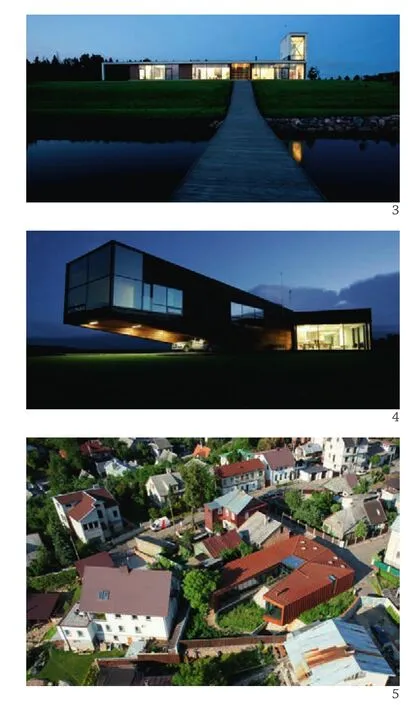
3-5纳特科维丘斯事务所设计的3种家庭住宅——农场住宅(2010),乌特里艾住宅(2006)及草莓街住宅(2011)/Three different family houses created by the Natkevičius studio – house in farmstead (2010), house in Utriai (2006) and house in Braškių street (2011).
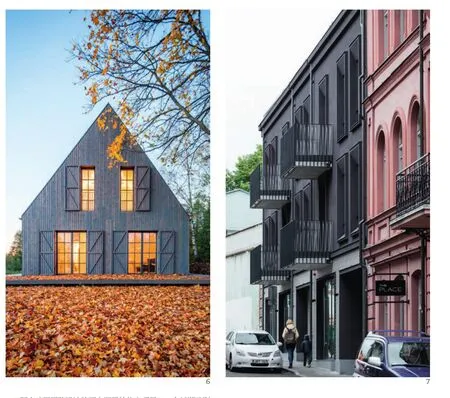
6.7阿克吐里团队设计的两个迥异的住宅项目——乡村湖畔别墅和位于苏巴丘斯大街19号的市区公寓楼/Two very different residential projects created by Aketuri team – rural Lakeside Villa and urban apartment building in Subačiaus str. 19.
P a l e k o建筑工作室成立于大约2 0年前,并赢得过多个国内外建筑竞赛。住宅建筑仅是其团队的工作范围之一,但却是十分重要的一个部分。拉苏纳迈住宅区的设计中,建筑师采用了原型化的传统住屋体量,令他们漂浮在紧邻的作为历史保护遗迹的军火地窖之上。同时,工作室进行着各类尺度的住宅建筑项目,曾在维尔纽斯的中心区域完成公寓住宅。即使在大型项目中,帕勒卡斯也试图植入趣味元素来歌颂日常生活的美好——庭院、露台、中庭,甚至简单的阳台都能够成为建筑中的核心元素和创造特有氛围的重要工具(图9、1 0)。
House in Strawberry street (Braškių g.) also designed by Natkevičius studio is the rusted introvert hiding its inner courtyard from the neighbors and opening it up to the view of the valley and intersection of the two rivers. Complicated geometry of the plot was used as a source of inspiration – architects proposed a structure that occupies almost the entire site. The façade, of blind rusted plates, merges with the visually inarticulate surroundings and adds up to the layered and unfinished atmosphere of the neighborhood. The glazed and open interior façades surround a tiny inner courtyard with a garden. It is a central element of building layout which connects different spaces visually and compositionally. Each and every project for Natkevičius office is different,but it always keeps an ability to surprise the spectator and to attract his attention (Fig. 6,7).
Quite a different approach might be seen in Aketuri architect's portfolio. They are trying to demonstrate an awareness of the natural and urban environment, respect to a heritage and traditional,natural materials. The team is always looking for its own distinctive architectural details that make a simple form into an interesting story. For example,the Lakeside Villa is decorated with monochromatic wooden siding and its character is formed by thoughtfully composed windows with shutters and a sharp gable roof. Such roof is a common feature in the Aketuri designs and it plays with the familiar form by transforming it in too more specific and unexpected one. The shutters are used as a safety tool and a reference to traditional Lithuanian village architecture.The simple and logical layout of interior spaces,the views visible from the windows and the laconic interior – all the features of this buildings give proper respect to the natural surrounding where the house is situated within intimate feeling of domesticity (Fig. 8).
The Paleko ARCH studio was established almost two decades ago, and since then it has been successful in a number of architectural competitions locally and abroad. Residential design is only a part of the scope that Palekas team is working with, but quite an important one. They have created such a subtle design as Rasų namai with the archetypal volume of the traditional house floating above the remains of protected historic amunition vaults situated next to the buildings. At the same time studio is working on small and large scale residential buildings and they have designed apartment buildings in the very central locations of Vilnius. Even in the big scale projects,Palekas team is trying to insert element playfulness and celebrate the joy of the everyday life – courtyards,terraces, atriums, or simple balconies in Palekas designs become a core element of the building and an important tool to create a specific atmosphere of the property (Fig. 9,10).
Architect Audrius Ambrasas is also known for an ability to orchestrate the building with specific atmosphere. He is working on projects of different scale, and some of them already became a landmark of Vilnius city. However atmospheric properties and strong sensibility of the author is especially visible in a residential architecture. Luxury villas that were designed by Ambrasas are expressive, yet they are"silent". He likes to play with light, bent surfaces and fluid spaces in most of the projects and not only residential ones. Buildings such as Villa G and Villa N is not an exception. They are inspired by nature and smoothly blends in the surroundings. Concrete walls, wood, copper, stone – all the materials are raw,natural and they are contributing to the sense of the place as well. Long horizontal volumes lead an eye of the spectator through the landscape and frame picturesque greenery around the building (Fig. 11,12).
The other office that is worth mentioning is Arches – studio of architectural aesthetics. Arches are also known for luxury villas, but also for the design of major public buildings. Most of their residential designs are situated in an impressive natural environment and resort areas. They are also recognised for their recreational designs and playfully decorated facades. One of the most nominated projects – Nakcižibis resort (2008) and Valley villa(2017). Both of these projects shows professional usage of wood as the main façade material and interpretation of archetypal silhouette of the traditional gable-roof house. In 2017, Valley Villa won the annual international Residential Architecture Design Awards Grand Prix in the category Custom House More Than 3000 Square Feet organised by The Magazine of the American Institute of Architects and this was the first such awarded received by the project from Eastern Europe (Fig. 13).
Interesting experimentation can be found in the designs of smaller studios and the younger architects.They are eager to try unconventional solutions and it is always a pleasure to see how they are thinking outside the box. For example, Andrius Skiezgelas decided to be a developer and the architect of a four clustered apartments near the Baltic sea. Rough concrete volumes arranged around the inner courtyard are modular and they have vast possibilities how internal space could be transformed. Only the core with sanitary equipment is a rigid element of the floor layout, while all the other walls can be transformed according to the needs of new inhabitants. Clean,minimalistic concrete boxes are a background to the designer furniture and a colourful life that will unfold in such space (Fig. 14).
Other young architects are also experimenting with typologies – they are designing small studio apartments, row housing designs with shared community spaces and inspiring paper architecture about future habitation. Also, studios such as YCL are experimenting with materials and details of the residential interior. Architect Mykolas Svirskis with colleagues designed a house for a young family with raw blocks façade made out of the light expanded clay aggregate. "Do Architects" suggested cylindrical volume design of the Rolling Homes next to the seaside. A new generation of young architects are just starting to find their creative identity, but the continuity of the values established by the local architectural school remains.
建筑师奥德留斯·安巴萨斯也以赋予建筑特殊氛围的能力而闻名。在他设计的各类尺度的项目中,有一些早已成为维尔纽斯市的地标。但住宅作品却最具代表性地呈现了这位建筑师的强烈感知力及其意欲传达的氛围特质。他设计的奢华别墅,往往能将表现力生发于静谧之中。在不仅包含住宅的大多项目中,安巴萨斯热衷对光、弯曲表面和流动空间进行操作。在别墅G 和别墅N等住宅项目中也凸显了这些特征,受到自然启发而巧妙地渗入环境。混凝土墙体、木材、铜板、石材——一切材料都是原生的、自然的,也强化了场所感。水平的长体量引导观者的视线穿透景观,也框出了建筑周围如画的自然景色(图11、12)。
另外值得一提的事务所是Arches,这是一家极具建筑审美的工作室。Arches也有许多知名的奢华别墅作品,同时也设计过很多重要公共建筑。他们的多数住宅项目都坐落于风景壮丽的自然环境或度假胜地中。具有生趣的设计和戏剧化装饰的立面是他们的标志性特征。工作室最著名的项目包括了那科茨兹博斯度假村(2008)及山谷别墅(2017)。这两个作品的立面均对木材有着熟稔的使用,还呈现了传统坡屋顶住宅的原型轮廓。2017年山谷别墅赢得了由美国建筑师学会杂志举办的年度国际住宅建筑设计奖280m2以上类别的大奖,也是该奖项首次颁发给东欧国家的项目(图13)。
有趣的设计实验也发生在小型事务所和新一代建筑师中。他们非常渴望尝试打破陈规的解答,能够看到他们的大胆思路总是令人兴奋。例如,奥德留斯·谢科茨格拉斯自行开发并设计了一处波罗的海附近的组团公寓。围绕内部庭院排布的素混凝土体量是模块化的,提供了内部空间可变方式的高度可能性。除中心的卫生设备是平面布局中的固定元素外,其余所有的墙体均可根据新的生活习惯和需求而改变。简洁的、极少主义的混凝土方盒子也成为了设计师家具和在空间中展开的多彩生活的背景(图14)。
其他年轻建筑师也探索了类型学的可能性——他们设计了小型的成套公寓、整合社区空间的联排住宅以及面向未来居住方式的纸建筑等。YCL等工作室也进行了住宅室内材料和细部的实验。米库拉斯·苏瓦斯奇斯和同事为青年家庭设计了裸露轻质延展性粘土砖为立面材料单元的住宅。“Do 建筑事务所”为海边的旋转住宅提出了圆柱形体量。新一代的年轻建筑师们正刚刚开始找寻他们自己的创意特征,却依然传承着自本土建筑学校留存下来的价值观。
作为总结,立陶宛当代住宅建筑约经历了变动剧烈而硕果颇丰的30年。这不仅来自对当下全新生活方式的适应,也来自对前代建筑师的经验传承:尺度感知、材料和谐、环境意识等。即使在最新的设计中,两次世界大战期间的影响与北欧建筑学派的作用仍清晰可见。同时,创意实验和不断增多的年轻事务所致力于发展对语境或传统的个人化操作方法,住宅建筑是其中最主要的领域之一。对家庭空间的探索不应仅限于三维形体,更应成为一个编织日常生活的契机。本土建筑师们正在逐渐建立起立陶宛建筑的新世代。□
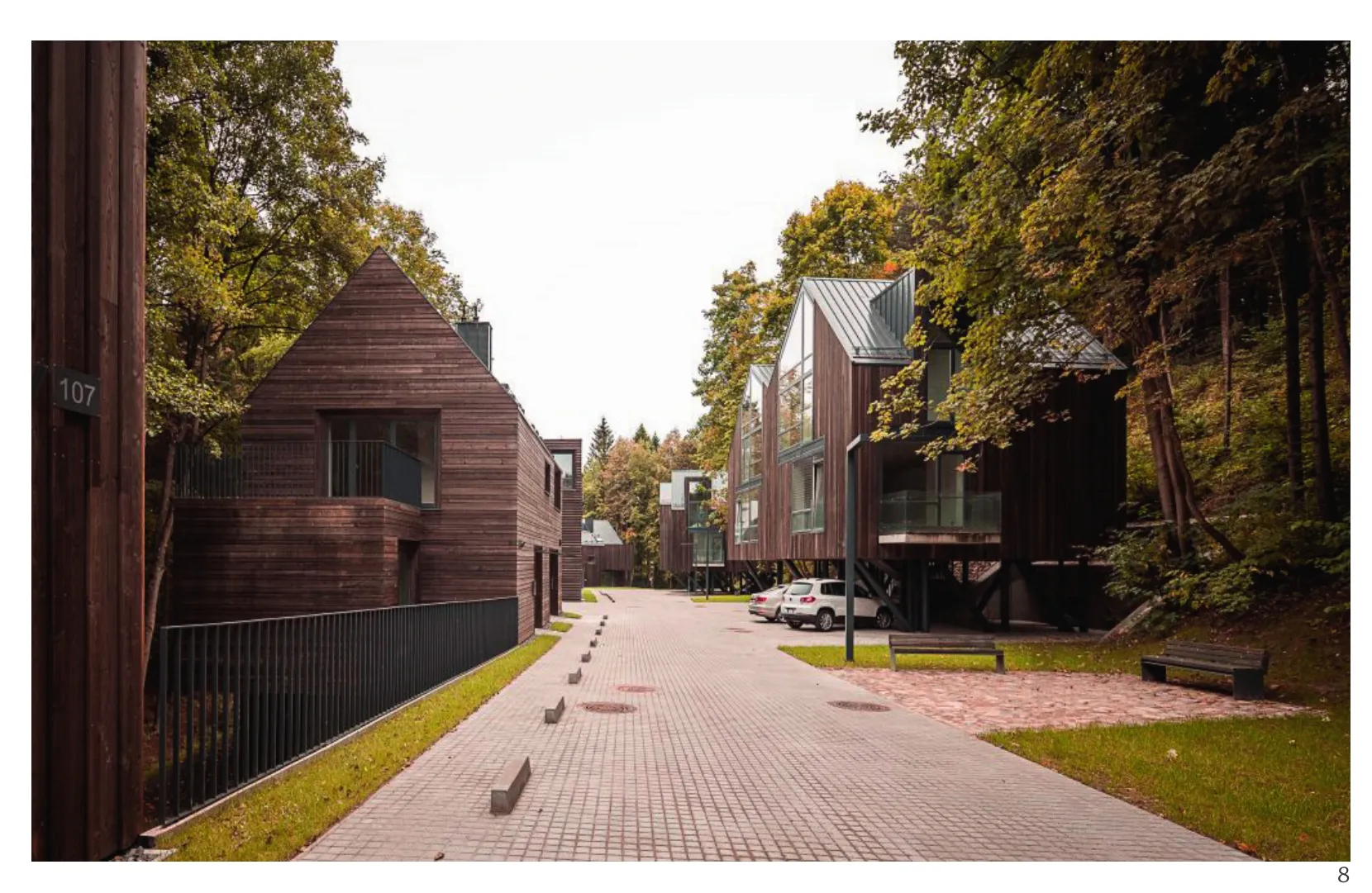
8与自然和文化遗产不可分割的拉苏纳迈住宅区,Paleko建筑工作室 + Plazma建筑工作室设计(2015)/The residential quarter "Rasu namai" is deeply related to both nature and heritage. Design by Paleko ARCH studio + Plazma Architecture Studio (2015).
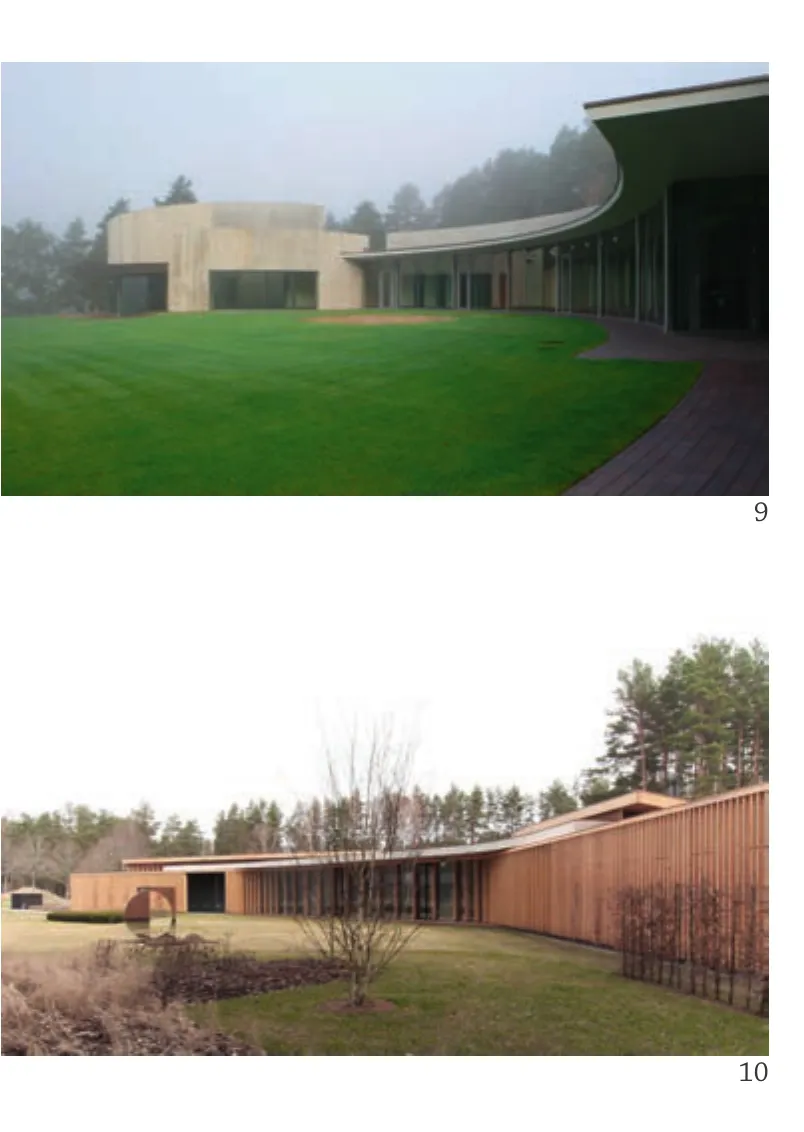
9.10奥德留斯·安巴萨斯设计的别墅N(2007)和别墅G(2014),两者都遵循与自然环境相协调的设计手法/Vila N (2007) and Vila G (2014) designed by architect Audrius Ambrasas both follow similar approach to natural enviroment.

14Arches设计的科茨兹博斯度假村(2008年)和山谷别墅(2017年)差了将近10年,两个项目都顺应了大自然/There is almost a ten years gap between Nakcižibis resort(2008) and Valley villa (2017) designed by Arches, but both of the projects beautiflly sets in the nature.
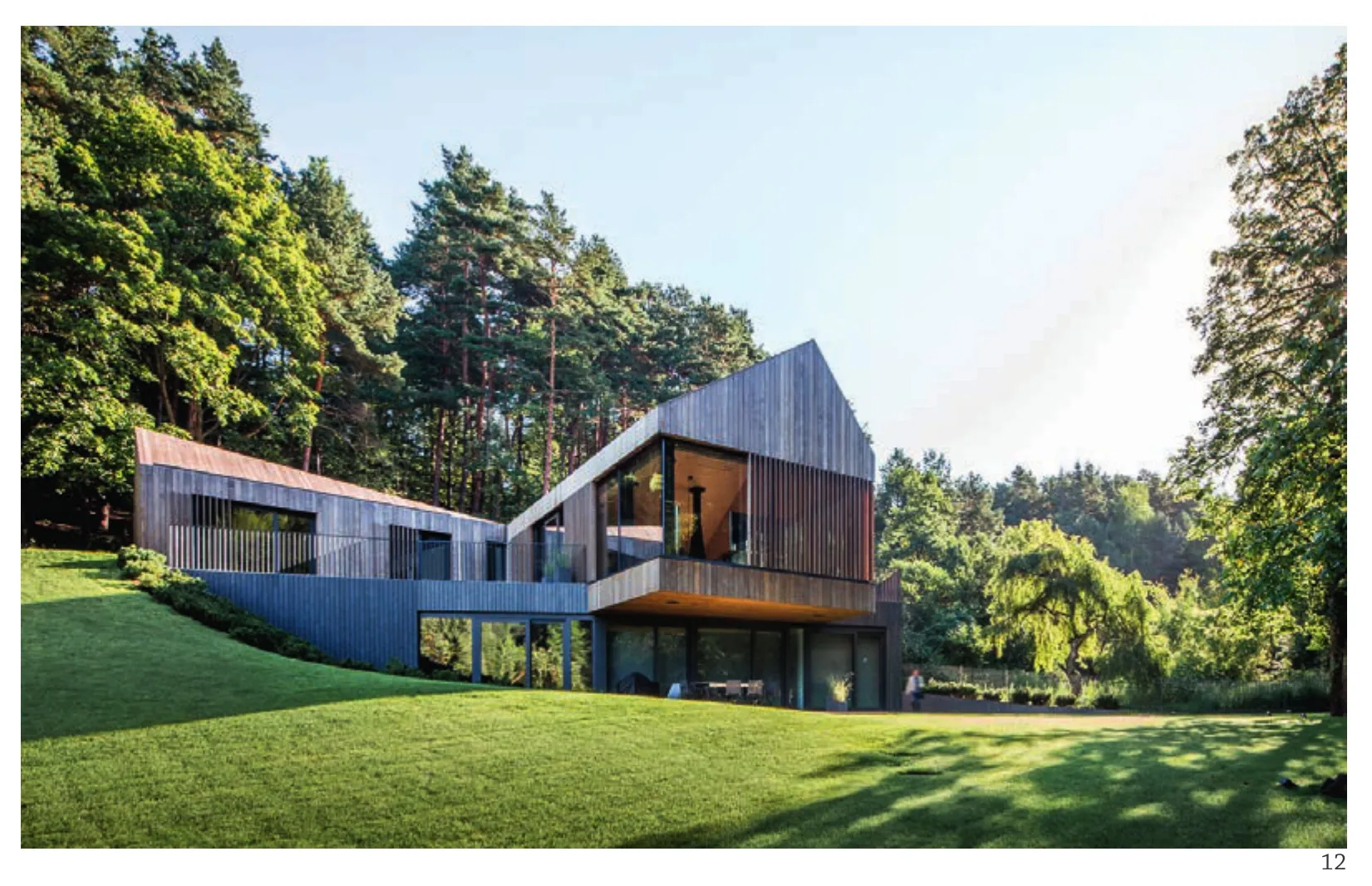
13奥德留斯·谢科茨格拉斯设计的滨海4住宅组团(2016)/Kankorėžis – a residential project of four clustered houses close to the seaside was designed by Andrius Skiezgelas (2016).
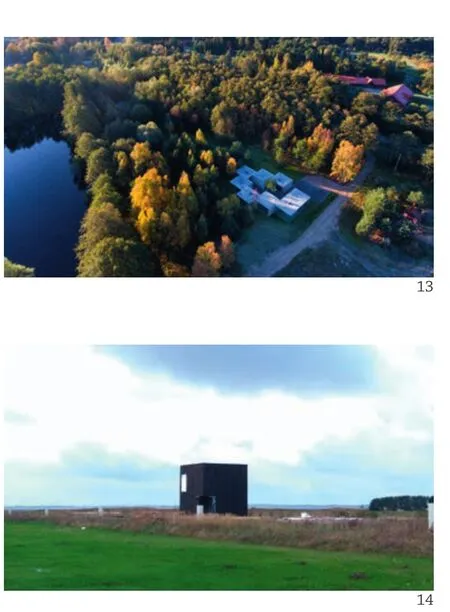
14米库拉斯·苏瓦斯奇斯设计的住宅常置于大自然中,或临湖,或滨海/The architecture of Mykolas Svirskis is often in nature and often next to the lake, river or sea.
In summing up contemporary residential architecture in Lithuania experienced almost three intense and fruitful decades. This has happened not only by adjusting to the new lifestyle of today, but also by transferring experience of the previous generations of architects: a sense of scale, harmony of materials, and an awareness of the environment. Even in the new designs influence of interwar period and Scandinavian school of architecture is still visible. But at the same time one can find new creative experiments and growing numbers of young studios that works hard in order to develop their personal approach towards the context or tradition.Residential architecture is one of the main fields for experimentation for them. By working on domestic architecture not only as the three dimensional object,but also as an opportunity to orchestrate everyday life local architects are slowly developing a new, modern generation of Lithuanian architecture.□
